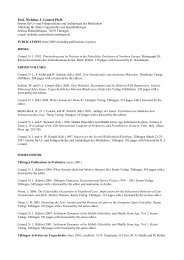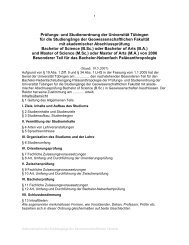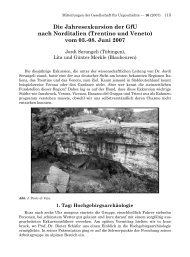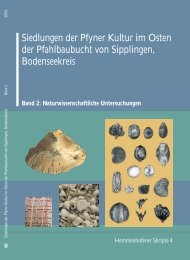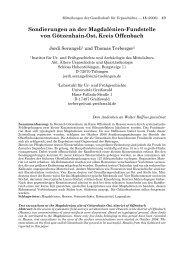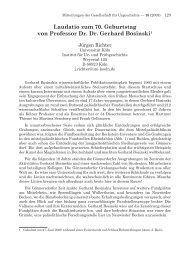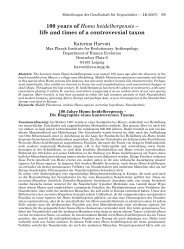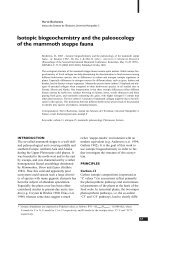bronze age environment and economy in the troad - Universität ...
bronze age environment and economy in the troad - Universität ...
bronze age environment and economy in the troad - Universität ...
You also want an ePaper? Increase the reach of your titles
YUMPU automatically turns print PDFs into web optimized ePapers that Google loves.
chapter 1: <strong>environment</strong> <strong>and</strong> archaeology<br />
to have been unsuitable for a dense tree growth. Already<br />
dur<strong>in</strong>g <strong>the</strong> second part of <strong>the</strong> Postglacial (from 7000 BP<br />
onwards) <strong>the</strong> anthropogenic <strong>in</strong>fluence becomes significant. The<br />
first recognisable <strong>in</strong>fluence of man on <strong>the</strong> vegetation is with<br />
agriculture <strong>and</strong> pastoral activities, but accord<strong>in</strong>g to Pons <strong>and</strong><br />
Quézel (1985), <strong>the</strong>re is still not enough knowledge about<br />
anthropogenic <strong>in</strong>fluence for prehistoric periods, because of<br />
<strong>in</strong>adequate location of pollen sites. Human <strong>in</strong>fluence on <strong>the</strong><br />
vegetation <strong>in</strong> relation to <strong>the</strong> formation of maquis vegetation has<br />
recently provoked controversial discussions. A short<br />
presentation of this aspect is given <strong>in</strong> chapter 4.<br />
Vegetation history for <strong>the</strong> Troad is <strong>in</strong>directly recorded, or deduced<br />
from Greek pollen data <strong>in</strong> van Zeist <strong>and</strong> Bottema (1991).<br />
Accord<strong>in</strong>g to this scheme <strong>the</strong> modern woodl<strong>and</strong> is a relict of<br />
sclerophyllous mixed forest.<br />
From palaeogeographic <strong>in</strong>vestigations (Kayan 1996) we know<br />
about <strong>the</strong> slow progradation of <strong>the</strong> delta. The ground water<br />
level was high, <strong>and</strong> <strong>the</strong>refore marshy vegetation was widespread<br />
with<strong>in</strong> <strong>the</strong> area. Wood cutt<strong>in</strong>g <strong>and</strong> clear<strong>in</strong>g of <strong>the</strong> vegetation<br />
was surely practiced from <strong>the</strong> beg<strong>in</strong>n<strong>in</strong>g of <strong>the</strong> settlements,<br />
<strong>and</strong> <strong>the</strong>re are signs from soil science (Pustovoytov <strong>in</strong><br />
prep.), archaeozoology <strong>and</strong> not least from archaeobotany, that<br />
<strong>the</strong> vegetation was already partially open, but still with larger,<br />
oak wooded areas (Uerpmann, Köhler <strong>and</strong> Stephan 1992) <strong>in</strong><br />
Early Bronze Age.<br />
The l<strong>and</strong>scape descriptions of <strong>the</strong> last century by Barker-Webb<br />
(1822) <strong>and</strong> Virchow (1879) show a vegetation very similar to<br />
<strong>the</strong> modern. Only <strong>the</strong> valley, which is well dra<strong>in</strong>ed today, was<br />
more marshy.<br />
1.1.3 The history of archaeobotanical<br />
research <strong>in</strong> <strong>the</strong> Troad<br />
The excavations by Blegen from 1932 gave first rise to systematic<br />
archaeobotanical <strong>in</strong>vestigations <strong>in</strong> Troy. Phytolith<br />
analysis of cultural layers ma<strong>in</strong>ly from Troy I/II was conducted<br />
by Rapp <strong>and</strong> Mulholl<strong>and</strong> (Mulholl<strong>and</strong>, Rapp, <strong>and</strong> Gifford<br />
1982, Mulholl<strong>and</strong> <strong>and</strong> Rapp 1987). Samples were taken, e.g.<br />
from burnt bricks of <strong>the</strong> Troy II Megaron IIA, a witness of <strong>the</strong><br />
early blossom<strong>in</strong>g of <strong>the</strong> city, but also from ashy layers <strong>and</strong> soil<br />
predat<strong>in</strong>g <strong>the</strong> settlement. The aim of conduct<strong>in</strong>g <strong>the</strong>se analyses<br />
was to recognise changes <strong>in</strong> past plant communities <strong>and</strong> plant<br />
use by humans. Rapp <strong>and</strong> Mulholl<strong>and</strong> found that stems of <strong>the</strong><br />
grass Arundo donax (giant reed), which is common on<br />
Mediterranean river sides, was <strong>the</strong> ma<strong>in</strong> contributor to <strong>the</strong><br />
phytoliths <strong>in</strong> almost all <strong>the</strong> samples <strong>and</strong> was possibly used as<br />
build<strong>in</strong>g material. The samples from <strong>the</strong> Megaron brick conta<strong>in</strong>ed<br />
only few phytoliths, ma<strong>in</strong>ly grass. These bricks were<br />
also sampled for pollen with better success (Huber <strong>and</strong> Rapp<br />
1987). The taxa recorded were P<strong>in</strong>us sp. (p<strong>in</strong>e), Quercus sp.<br />
(oak), Pistacia sp. (pistachio), Asphodelus sp. (asphodel),<br />
Caryophyllaceae (p<strong>in</strong>k family), Gram<strong>in</strong>eae (grass family), <strong>and</strong><br />
Compositae (daisy family), a very typical comb<strong>in</strong>ation for <strong>the</strong><br />
Mediterranean. Earlier pollen analysis was conducted by<br />
Gennett <strong>and</strong> Gifford, also with samples from archaeological<br />
layers (Gennett <strong>and</strong> Gifford 1982). They found very high<br />
numbers of P<strong>in</strong>us pollen.<br />
Besides <strong>the</strong> <strong>in</strong>vestigations on phytoliths <strong>and</strong> pollen, analyses of<br />
botanical macrofossils were conducted. The latest analysis by<br />
Shay is based on two samples of emmer gra<strong>in</strong> from Troy I<br />
levels (Shay, Anderson, <strong>and</strong> Shay 1982).<br />
Earlier analyses were similarly restricted to small amounts of<br />
material (Schiemann 1951, L<strong>in</strong>dau 1922, Wittmack 1890).<br />
Wittmack identified plant rema<strong>in</strong>s from stor<strong>age</strong> rooms that<br />
were sampled by Virchow. The rema<strong>in</strong>s were dated to Troy II<br />
levels. This ‛wheat’ was abundant <strong>in</strong> “h<strong>and</strong> high” (!) elongated<br />
layers (Virchow 1879, p. 68). There was a lot of confusion<br />
with <strong>the</strong> identifications. First <strong>the</strong> wheat was identified as<br />
Triticum durum var. trojanum (Wittmack 1881, p. 779) <strong>and</strong><br />
thought to be emmer. Then Wittmack made several revisions<br />
of his identifications so that his former Triticum durum var.<br />
trojanum changed to Triticum vulgare var. trojanum <strong>and</strong> was<br />
thought to be two-gra<strong>in</strong>ed e<strong>in</strong>korn (Wittmack 1886, p. 33). The<br />
wheat gra<strong>in</strong>s from <strong>the</strong>se earlier layers (older than Troy II) were<br />
described as bigger <strong>and</strong> thicker than <strong>the</strong> later f<strong>in</strong>ds (Wittmack<br />
1890). Schiemann (1951) corrected Wittmack’s identifications<br />
fur<strong>the</strong>r. Several of <strong>the</strong> former Triticum monococcum gra<strong>in</strong>s<br />
were now designated as Triticum dicoccum. This confusion<br />
<strong>in</strong>dicates <strong>the</strong> problems of cereal gra<strong>in</strong> identification <strong>in</strong> general.<br />
At that time, sampl<strong>in</strong>g was not advanced enough to extract <strong>the</strong><br />
more readily identifiable chaff rema<strong>in</strong>s.<br />
Besides <strong>the</strong> cereals, Schiemann found silica skeletons of Hordeum<br />
cf. maritimum (sea barley), Bromus sp. (brome grass).<br />
<strong>and</strong> Vitis v<strong>in</strong>ifera. O<strong>the</strong>r crops found by Wittmack <strong>in</strong> Troy II<br />
layers were Pisum sativum, Vicia faba <strong>in</strong> m<strong>in</strong>or amounts <strong>and</strong><br />
small lentils (2.3 mm <strong>in</strong> diameter). Fur<strong>the</strong>r rema<strong>in</strong>s from a<br />
layer, older than <strong>the</strong> previous, which were collected from vessels,<br />
<strong>in</strong>cluded ma<strong>in</strong>ly wheat <strong>and</strong> Vicia ervilia. The only weed<br />
that was mentioned by Wittmack was Fumaria sp. (fumitory),<br />
which was a modern contam<strong>in</strong>ant <strong>in</strong> <strong>the</strong> samples.<br />
Consider<strong>in</strong>g <strong>the</strong> rich f<strong>in</strong>ds of early excavations <strong>and</strong> <strong>the</strong> <strong>in</strong>complete<br />
study of this material, it is very regrettable that most of<br />
<strong>the</strong> plant rema<strong>in</strong>s from Virchow’s collection disappeared<br />
dur<strong>in</strong>g wartime. A part of Schiemann’s collection is now <strong>in</strong> <strong>the</strong><br />
Botanical Garden <strong>in</strong> Berl<strong>in</strong>-Dahlem (Raus 1992), but <strong>the</strong><br />
orig<strong>in</strong>al material was destroyed by bomb<strong>in</strong>g dur<strong>in</strong>g <strong>the</strong> Second<br />
World War (Kilian 1997). Huge amounts of gra<strong>in</strong> excavated<br />
dur<strong>in</strong>g Blegen’s excavations are also lost, i.e. <strong>the</strong>y are not <strong>in</strong><br />
<strong>the</strong> archives of <strong>the</strong> museums <strong>in</strong> Çanakkale or Istanbul (Rose,<br />
pers. com.).<br />
Beside <strong>the</strong> new <strong>in</strong>vestigations (s<strong>in</strong>ce 1991) <strong>in</strong> Troy <strong>and</strong> Kumtepe<br />
no o<strong>the</strong>r archaeobotanical research has been conducted <strong>in</strong><br />
western Anatolia until recently, when Dr. Emel Oybak (Izmir<br />
Region Excavations <strong>and</strong> Research Project Team) started <strong>in</strong><br />
1996 with archaeobotanical analysis from <strong>the</strong> sites Bakla Tepe<br />
(Chalc.-Early Bronze Age) <strong>and</strong> Liman Tepe (Chalc.-Late<br />
Bronze Age) <strong>in</strong> <strong>the</strong> Izmir prov<strong>in</strong>ce (Oybak 1997).<br />
1.2 The archaeology of Kumtepe <strong>and</strong> Troy<br />
<strong>and</strong> <strong>the</strong> orig<strong>in</strong> of <strong>the</strong> samples<br />
The geographical position of <strong>the</strong> Troad between <strong>the</strong> Black Sea<br />
region <strong>and</strong> <strong>the</strong> Aegean on one side <strong>and</strong> <strong>the</strong> prehistoric settlement<br />
centres of Inner Anatolia on <strong>the</strong> o<strong>the</strong>r side, def<strong>in</strong>es it as a<br />
focal po<strong>in</strong>t of cultural <strong>and</strong> economic relations dur<strong>in</strong>g <strong>the</strong> prehistory<br />
of <strong>the</strong>se regions.<br />
The follow<strong>in</strong>g paragraphs summarise <strong>the</strong> early archaeological<br />
6





